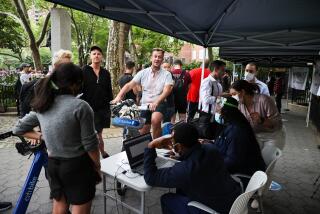Great Read: Ebola doctor’s dilemma: Two patients, and drugs enough for one
- Share via
Dr. Lance Plyler prayed. He had a choice to make.
Two colleagues at a hospital in Liberia, Dr. Kent Brantly and Nancy Writebol, were battling the deadly Ebola virus. The air ambulance had turned back with a mechanical problem, and Plyler feared they wouldn’t survive much longer.
Against the odds, the medical missionary from North Carolina had managed to find some of the last available supplies of a promising new drug, ZMapp, in neighboring Sierra Leone.
A Styrofoam box containing three frozen vials of straw-colored fluid was flown to the border, canoed across a river and put on a plane to Monrovia, the Liberian capital. But there was enough to treat only one person.
The developers were insistent: It would take all three doses to knock out the virus.
“Whatever you do,” they told him, “don’t split the course.”
::
Brantly, a 33-year-old Indianapolis native, had arrived in Liberia in October 2013 with his wife, Amber, 30, and their two young children to begin a two-year mission with the American Christian aid group Samaritan’s Purse.
Brantly went to work at the hospital in the sprawling ELWA campus, also home to a Christian radio station and school.
They lived in a tin-roofed house on the Atlantic Ocean, surrounded by a close community of friends and colleagues. Among them were David Writebol, a missionary with another aid group at the compound, SIM. His wife, Nancy, became like a surrogate grandmother to the Brantlys’ son and daughter.
The work was challenging. The facilities were rudimentary and patients would show up very late in the course of their illness. “Death was ever present,” Brantly said.
But nothing prepared him for what was to come.
Their first Ebola patient arrived June 11, a young woman named Theresa. She was accompanied by an uncle, but he died before the pair could be unloaded from an ambulance. Days later, Theresa too was dead.
With no facilities to treat Ebola patients, a chapel was converted into an isolation ward with six beds separated by tarp barriers. Soon the unit was overflowing with desperately ill patients. So the hospital built a larger one. That too quickly filled up. The staff members — a mix of Liberians and expatriates — were working up to 18 hours a day caring for the patients.
“Ebola is a humiliating disease,” Brantly said. “It’s humiliating for patients who have to be isolated: They have no direct contact with another human being; they lose control of their bodily functions. But it is also humiliating ... for the healthcare workers who are trying to take care of these people because there is so little that you can do.”
Brantly did what he could. Then he held his patients’ hands and sang to them as they died.
On July 23, Brantly woke up feeling ill. He called Plyler, who had been sent to Liberia by Samaritan’s Purse to oversee the group’s response to the Ebola crisis.
“I remember verbatim what he said to me,” Plyler recalled. “He said, ‘Lance, don’t freak out, but I have a fever.’”
Amber and the kids were in the U.S. for a wedding, so they agreed that Brantly would quarantine himself at home while they figured out what was wrong.
Brantly thought he must have malaria, a mosquito-borne disease that is endemic to the region. But the tests were negative. So too was his first Ebola test, but he needed another one to confirm the result. Three days later, Brantly awoke from a feverish fog to find Plyler standing at his bedroom window.
“Kent, bud, we have your test result,” Brantly recalled him saying. “I’m really sorry to tell you it’s positive for Ebola.”
Brantly had known only one patient who beat Ebola, but he didn’t feel afraid.
“I had a very real sense of peace in that moment that I can only attribute to the grace of God,” he said. “My first words were: ‘OK, what’s next? What’s our plan?’ And then my next thought was, ‘How am I going to tell Amber?’”
That evening, Plyler learned that Nancy Writebol, 59, had also tested positive for Ebola. She had helped the doctors and nurses working in the Ebola ward, spraying them with a chlorine solution so they wouldn’t infect themselves when they removed their protective clothing.
When he broke the news to the rest of the staffers, they were terrified. They had followed the safety protocols and didn’t know how their colleagues could have become infected. Three Liberians — a physician assistant, a nurse and a hygienist — also fell ill, and two died. Others stopped coming to work, afraid they too would catch the virus.
“It’s like the hidden enemy,” Plyler said. “You didn’t know where it lurked.”
::
Back in the U.S., officials at Samaritan’s Purse were struggling to find a company that would transport their colleagues to a country where they could receive more advanced care.
No one would take Ebola patients, said the Rev. Franklin Graham, the group’s leader. When a specially outfitted Phoenix Air ambulance finally took off for Liberia on July 30, it had to turn back because of a pressurization problem.
In the meantime, Plyler had reached out to the U.S. Centers for Disease Control and Prevention and the National Institutes of Health for information about experimental treatments.
They introduced him to the U.S. and Canadian scientists behind ZMapp, a cocktail of genetically engineered antibodies designed to boost the body’s immune response to Ebola. The drug seemed promising in trials involving monkeys, but it had never been tested in humans. Only a few doses were available, and researchers didn’t know whether they would help his patients — or make matters worse.
One course of treatment, Plyler learned, had just been offered to Dr. Sheik Humarr Khan, an expert on hemorrhagic fevers who had cared for more than 100 Ebola patients in Sierra Leone before contracting the virus.
Khan’s medical team from Doctors Without Borders agonized over the ethics of using a drug whose safety was not known and favoring one sick person over countless others. Members of the team also worried about the risk of a popular backlash should the drug be perceived to have killed a national hero.
In the end, they decided against using ZMapp. Khan died July 29.
Plyler was concerned about the possibility of a deadly allergic reaction. No one had taken the drug before. But he was running out of time and options. So he asked whether the ZMapp could be sent to the ELWA compound.
::
The morning after the ZMapp arrived, Brantly woke up feeling like he had turned a corner. He was worried about Nancy Writebol, who was older and sicker than he was. He told Plyler to give her the ZMapp.
But first, they had to defrost the drug. Too much heat could destroy the antibodies, so they had to improvise: They tucked a vial under Nancy Writebol’s arm and waited for it to slowly thaw.
That night, Brantly started to deteriorate. By the following evening, Plyler was convinced he was about to die.
“He had a 105-degree fever, he was breathing about 30 times a minute, and he just had this incredibly toxic appearance,” Plyler said.
Plyler knew what he had to do: He had to split the ZMapp and pray more would be available in the United States.
Plyler raced to the Writebols’ house and asked the attending physician, Dr. Debbie Eisenhut, an Oregon native who worked for SIM, to retrieve the vial under Nancy Writebol’s arm. The doctor placed it in a plastic bag, sprayed it with chlorine solution, then handed it to Plyler in a plastic bucket. He then drove back to Brantly’s house and handed the bucket to Dr. Linda Mobula, a Samaritan’s Purse volunteer from Maryland, who administered the drug through an IV drip.
Soon after the treatment started, Brantly started shaking alarmingly.
“I remember looking at that nurse who was standing at my bedside and saying, ‘I don’t know how you’re going to breathe for me when I quit breathing,’ because I thought there’s no way I can keep this up,” he said.
But after about an hour, the shaking stopped; his temperature fell, and his breathing became more regular.
“He hadn’t walked in a day and a half, and just of his own volition, he got up and went to the bathroom,” Plyler said.
By the time the evacuation plane for Brantly reached Monrovia, he was able to walk out of the house and into an ambulance. His colleagues gathered round and cheered.
::
Nancy Writebol was given two doses of ZMapp while waiting for the plane to return for her. Her response wasn’t as dramatic, but she improved enough to ask for a favorite Liberian dish: potato soup.
The manufacturers provided Emory University Hospital in Atlanta with enough ZMapp for both to complete their treatment when they arrived in August. It’s impossible to know scientifically whether that’s what saved them. Brantly was also given plasma donated by his former patient who survived Ebola. Early detection and intensive supportive care also may have aided their recovery.
But Plyler has his own opinion: “Prayers and antibodies — in that order.”
More to Read
Sign up for Essential California
The most important California stories and recommendations in your inbox every morning.
You may occasionally receive promotional content from the Los Angeles Times.











